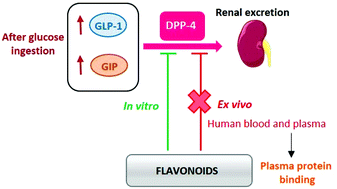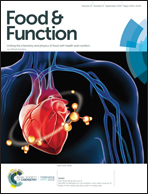The dipeptidyl peptidase-4 inhibitory effect of flavonoids is hindered in protein rich environments†
Abstract
Dipeptidyl peptidase-4 (DPP-4) inhibitors present a unique approach for the management of type 2 diabetes (T2D). In the present study, the inhibition of DPP-4 was evaluated for a large panel of flavonoids, important components of the human diet, using in vitro and ex vivo models. The activity of the isolated enzyme was assayed in vitro. Subsequently, the most active flavonoids were tested ex vivo in human whole blood and plasma. In this study, contrary to the in vitro fluorometric tests, flavonoids did not show inhibitory activity against DPP-4. Due to the discrepancy in the results between the in vitro and ex vivo approaches, plasma protein binding values were determined, presenting values from 43.9 to 100.0%. This work provides a new insight into the inhibitory activity for DPP-4, based on the flavonoid scaffold. Additionally, the obtained results showed that the inhibitory effect of flavonoids against DPP-4 was hindered in protein rich environments, like that occurring in blood, and indicated the need for experimental refinement in drug discovery for blood targets.



 Please wait while we load your content...
Please wait while we load your content...